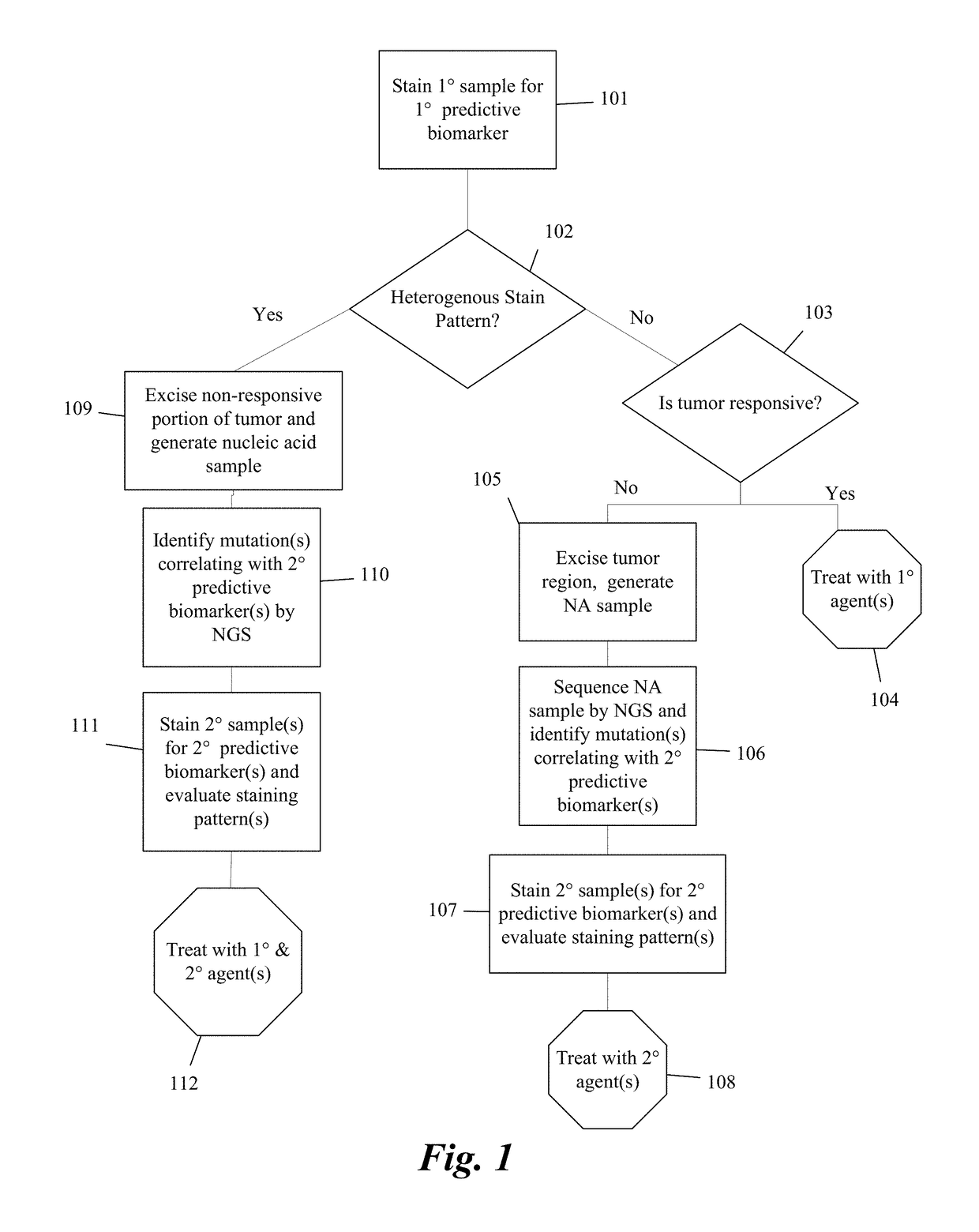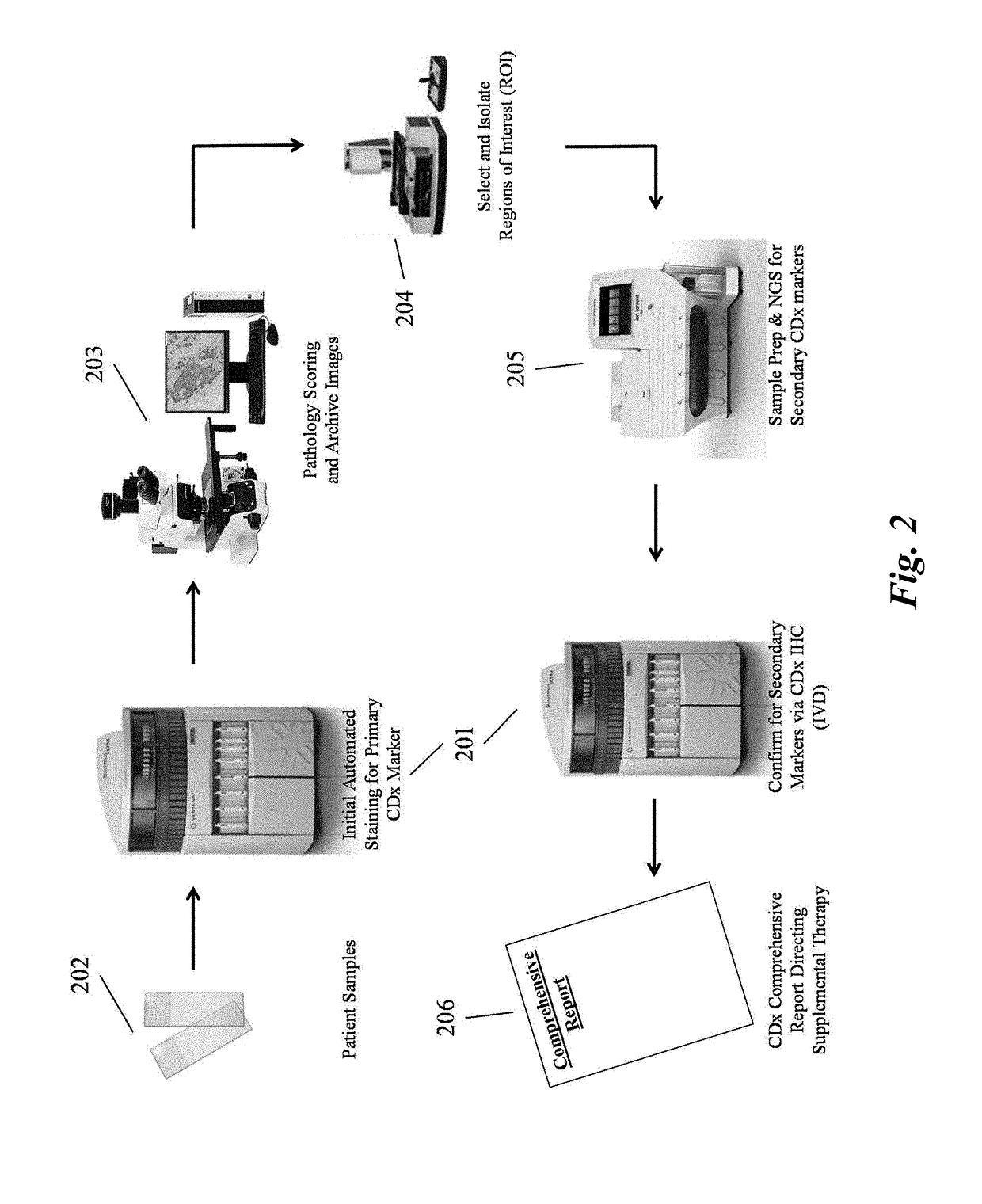Predictive diagnostic workflow for tumors using automated dissection, next generation sequencing, and automated slide stainers
a technology of automated dissection and tumors, applied in the direction of instruments, biochemistry apparatus and processes, material analysis, etc., can solve the problems of not providing any information about the spatial relationship of mutations or how mutations are inter-related from a functional standpoin
- Summary
- Abstract
- Description
- Claims
- Application Information
AI Technical Summary
Benefits of technology
Problems solved by technology
Method used
Image
Examples
embodiment 7
8. The method of embodiment 7, wherein the solid tumor is a formalin-fixed, paraffin-embedded (FFPE) tissue sample, and the first sample and the additional sample(s) are microtome sections of the FFPE tissue sample.
embodiment 8
9. The method of embodiment 8, wherein first sample and the additional sample(s) are serial sections.
10. The method of any of embodiments 1-9, wherein the next generation sequencer operates on a principle selected from the group consisting of pyrosequencing, cyclic reversible termination, semiconductor sequencing technology, and phospholinked fluorescent nucleotides.
11. The method of any of embodiments 1-10, wherein the first predictive biomarker and the additional predictive biomarker(s) are selected from the group consisting of ALK, ATM, BCL2, BRAF, BRCA1, c-KIT, CAIX, CCR4, CD30, Claudin, 17p13.1, DLL3, EGFR1, estrogen receptor, EREG, ERCC1, FGF19, FGFR2b, FGFR3, FOLR1, hyaluronan, HER2 / NEU, K-ras, MGMT, MSLN, p53, MDM2, progesterone receptor, PD-L1, PDGFRB, PTEN, and thymidine phosphorylase.
12. A system comprising:[0132](a) a set of microscope slides comprising:[0133](a1) a first microscope slide having deposited thereon a first sample of a tumor, wherein the first sample is his...
embodiment 14
15. The system of embodiment 14, wherein the label automatically directs the automated slide stainer to execute the instructions on the second sample.
16. The system of embodiment 14, wherein the label generates a report for an operator of the automated slide stainer, the report instructing the manual operator to program the automated slide stainer to execute the instructions on the second sample.
17. The system of any of embodiments 12-16, wherein the next generation sequencer operates on a principle selected from the group consisting of pyrosequencing, cyclic reversible termination, semiconductor sequencing technology, and phospholinked fluorescent nucleotides.
18. The system of any of embodiments 12-17, wherein the first predictive biomarker and the additional predictive biomarker(s) are selected from the group consisting of ALK, ATM, BCL2, BRAF, BRCA1, c-KIT, CAIX, CCR4, CD30, Claudin, 17p13.1, DLL3, EGFR1, estrogen receptor, EREG, ERCC1, FGF19, FGFR2b, FGFR3, FOLR1, hyaluronan, HE...
PUM
| Property | Measurement | Unit |
|---|---|---|
| Fluorescence | aaaaa | aaaaa |
Abstract
Description
Claims
Application Information
 Login to View More
Login to View More - R&D
- Intellectual Property
- Life Sciences
- Materials
- Tech Scout
- Unparalleled Data Quality
- Higher Quality Content
- 60% Fewer Hallucinations
Browse by: Latest US Patents, China's latest patents, Technical Efficacy Thesaurus, Application Domain, Technology Topic, Popular Technical Reports.
© 2025 PatSnap. All rights reserved.Legal|Privacy policy|Modern Slavery Act Transparency Statement|Sitemap|About US| Contact US: help@patsnap.com



